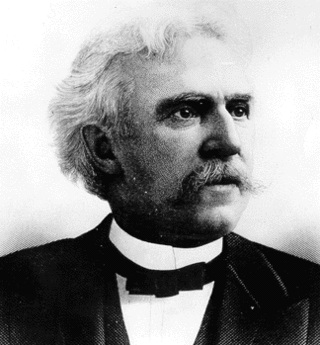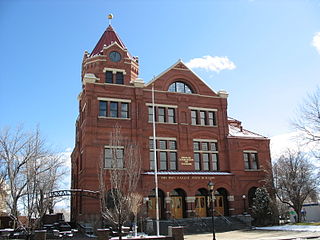
Lincoln is the capital of the U.S. state of Nebraska and the county seat of Lancaster County. The city covers 100.4 square miles (260.035 km2) and had an estimated population of 294,757 in 2023. It is the state's second-most populous city and the 71st-largest in the United States. Lincoln is the economic and cultural anchor of the Lincoln Metropolitan and Lincoln-Beatrice Combined Statistical Areas, home to 361,921 people.

James Renwick Jr. was an American architect in the 19th century, noted especially for designing churches and museums. The Encyclopedia of American Architecture calls him "one of the most successful American architects of his time".

John Edward McCullough was an Irish-born American actor.

Frederic Joseph DeLongchamps was an American architect. He was one of Nevada's most prolific architects, yet is notable for entering the architectural profession with no extensive formal training. He has also been known as Frederick J. DeLongchamps, and was described by the latter name in an extensive review of the historic importance of his works which led to many of them being listed on the U.S. National Register of Historic Places in the 1980s.

Randolph Rogers was an American Neoclassical sculptor. An expatriate who lived most of his life in Italy, his works ranged from popular subjects to major commissions, including the Columbus Doors at the U.S. Capitol and American Civil War monuments.

The Nevada Legislature is a bicameral body, consisting of the lower house, the Assembly, with 42 members, and the upper house, the Senate, with 21. With a total of 63 seats, the Legislature is the third-smallest bicameral state legislature in the United States, after Alaska's and Delaware's (62). The Nevada State Legislature as of 2019 is the first majority female State Legislature in the history of the United States. As of 2022, the Democratic Party controls both houses of the Nevada State Legislature. In the 2022 Nevada elections, which were a part of the midterm elections for that year, the Democratic Party obtained a supermajority in the lower house of the state legislature. As for the upper house of the state legislature, the elections provided the Democratic Party with thirteen of the twenty-one seats—amounting to a partisan composition of 61.9 percent.

Elijah E. Myers was a leading architect of government buildings in the latter half of the 19th century, and the only architect to design the capitol buildings of three U.S. states, the Michigan State Capitol, the Texas State Capitol, and the Colorado State Capitol. He also designed buildings in Mexico and Brazil. Myers favored Victorian Gothic and Neo-Classical styles, but he worked in other styles as well.

Samuel Sloan was a Philadelphia-based architect and best-selling author of architecture books in the mid-19th century. He specialized in Italianate villas and country houses, churches, and institutional buildings. His most famous building—the octagonal mansion "Longwood" in Natchez, Mississippi—is unfinished; construction was abandoned during the American Civil War.

Riverside Hotel is a former hotel and casino located in Downtown Reno, Nevada, that sits on the exact location where Reno began in 1859. The building now houses apartments and studios for artists and is listed on the National Register of Historic Places.

John Everett Tourtellotte was a prominent western American architect, best known for his projects in Idaho. His work in Boise included the Idaho State Capitol, the Boise City National Bank, the Carnegie Library, and numerous other buildings for schools, universities, churches, and government institutions. From 1922 to 1930, he worked in Portland, Oregon.
Benjamin Matthew Victor is an American sculptor living and working in Boise, Idaho. He is the only living artist to have three works in the National Statuary Hall in the United States Capitol. He is currently sculpting his fourth statue for the Statuary Hall, of Daisy Bates. He was only 26 years old when his first statue, Sarah Winnemucca, a Paiute activist in Nevada, was dedicated in the Hall in 2005, making him the youngest artist to ever be represented in the Hall. In 2014, his sculpture of Norman Borlaug, "the father of the Green Revolution," was dedicated in the National Statuary Hall and in 2019, his statue of Chief Standing Bear, a Native American rights leader, was dedicated in the National Statuary Hall making him the only living artist to have three sculptures in the Hall.

The Carson City Post Office is a historic building in Carson City, Nevada built from 1888 to 1891. It was designed by architect Mifflin E. Bell. It was listed on the National Register of Historic Places in 1979.
Edward Parsons (1907–1991) was an American architect who practiced in Nevada and was a leader in historic preservation. He was born in Tonopah, Nevada in 1907, went to school in Salt Lake City, Utah and in Reno, Nevada, and studied architecture at University of Southern California and the University of Pennsylvania.

The Thomas P. Kennard House, also known as the Nebraska Statehood Memorial, is the oldest remaining building in the original plat of Lincoln, Nebraska. Built in 1869, the Italianate house belonged to Thomas P. Kennard, the first Secretary of State for Nebraska, and one of three men who picked the Lincoln site for the new state's capital in 1867. The house was designed by architect John Keys Winchell of Chicago.
The history of Lincoln, Nebraska began with the settlement of the village of Lancaster in 1856. The county of Lancaster was founded in 1859. Prior to settlement from the westward expansion of the United States, Plains Indians, descendants of indigenous peoples who occupied the area for thousands of years lived in and hunted along Salt Creek. Settlers first came to extract salt from the wild salt flats of Salt Creek. Nebraska was granted statehood March 1, 1867. Soon afterwards a commission created by the State was appointed to locate the State Capital on State lands. The village of Lancaster was chosen for the Capital of Nebraska. The village of Lancaster became Lincoln. Lincoln was named after Abraham Lincoln. The first State Capitol was completed in 1868. Lincoln incorporated on April 1, 1869.
The following is a timeline of Lincoln, Nebraska history including significant social, political, cultural, and economic events in the history of Lincoln.
George C. Sellon was the first state architect of California. He resigned as State Architect on May 1, 1909 after the legislature passed a resolution to prevent him from working on his own designs and from bringing in private commissions as State Architect. He went on to form a private architectural practice in Sacramento in 1909, which later became Lionakis.
The Nebraska Capitol Commission is the State of Nebraska's official custodian of the Nebraska State Capitol. The seven-member commission and its corresponding executive agency, the Office of the Nebraska Capitol Commission, serve to assure "the highest quality preservation, restoration, and enhancement of and long-term planning for the State Capitol and capitol grounds for the perpetual use by state government and the enjoyment of all persons."

Thomas Perkins Kennard was a lawyer who served as Nebraska's first Secretary of State from 1867 to 1871. He was a member of the commission that chose Lincoln, Nebraska, as the site for the state capital.

Joseph Gosling was an architect in San Francisco. He is credited with designing the Nevada State Capitol. He also designed the Frank G. Edwards House in San Francisco. It is listed on the National Register of Historic Places. He had an office at 9 Post Street in San Francisco. He also designed Turk Street School.

















